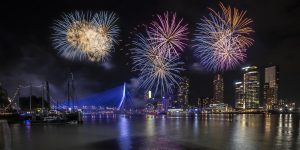Photographing in Rotterdam
Rotterdam, the port city of the Netherlands and also the largest in Europe. Not only one of the largest and most important cities in the Netherlands, but also a city with a lot of history and diversity. Because the historic center was largely destroyed during the bombardment in 1940, the city was rebuilt, so that the city is now a mix of historic districts and modern architecture. This makes Rotterdam a playground for photographers who love architecture and street photography.
bombardment in 1940, the city was rebuilt, so that the city is now a mix of historic districts and modern architecture. This makes Rotterdam a playground for photographers who love architecture and street photography.
The best photo locations in Rotterdam
- The Erasmus Bridge cannot be missing from the skyline of Rotterdam. This special building in the center of the city is definitely worth a visit. Especially in the evening when it is completely lit up. From the Kop van Zuid and opposite, you can shoot a beautiful panoramic picture with the Erasmus Bridge on it.
- Every year the national fireworks take place in Rotterdam at the Erasmus Bridge. This fireworks show is a spectacle to capture. Do you want to know more about photographing fireworks? Then read the photography tips item how to capture fireworks..
- A spectacular fireworks show can also be admired during the World Port Day to conclude this three-day event. During the event, visitors can get acquainted with the port and enjoy all kinds of demonstrations on the water, ship viewings and presentations.
- In addition to being a popular nightlife area, the Oude Haven is also a good location for photographing the old harbour. There are also several old ships in the harbor, which again creates a nice contrast between old and new.
 The Delfshaven in Rotterdam is a picturesque marina, which can still be admired in its original state. The characteristic mansions make it seem as if you are in Amsterdam.
The Delfshaven in Rotterdam is a picturesque marina, which can still be admired in its original state. The characteristic mansions make it seem as if you are in Amsterdam.- The popular cube houses are almost impossible to miss. Close to the Market Hall, the cube houses can be admired from below, which makes for a beautiful but interesting image.
- For a more industrial picture, the railway bridge De Hef is the place to be. De Hef, also known as Koningshavenbrug, is now a symbol of Rotterdam's industrial past.
- For nature lovers, the Kralingse bosgebied with pond is a nice place to photograph, and that in the heart of Rotterdam. With the greenery and the Kralingse plas in the foreground, the city center of Rotterdam still stands out.
- Whoever thinks of Rotterdam probably also immediately thinks of the Euromast. In addition to photographing the Euromast itself, it is also possible to look over the city at the panoramic points and photograph it from above.
Want to learn to photograph or gain experience?
Would you like to participate in the photography day in Rotterdam during the World Port Days? Then take a look at photography day Rotterdam and sign up! Or choose one of our other workshops.
More interested in a multi-day photography trip? Then there is bound to be something nice for you at the photography weekends- and trips.
Till clicks!



 Capturing water and air
Capturing water and air Does your composition have a straight horizon? Then it is best to use a hard filter. For example, if you have a mountainous landscape, a soft filter is recommended. A soft filter has a soft gradient and thus gradually changes in density, while a hard filter has a tighter transition.
Does your composition have a straight horizon? Then it is best to use a hard filter. For example, if you have a mountainous landscape, a soft filter is recommended. A soft filter has a soft gradient and thus gradually changes in density, while a hard filter has a tighter transition. Want to learn to photograph or gain experience?
Want to learn to photograph or gain experience?









Recente reacties